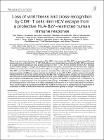| dc.contributor.author | KELLEHER, DERMOT P | |
| dc.date.accessioned | 2009-10-05T17:44:04Z | |
| dc.date.available | 2009-10-05T17:44:04Z | |
| dc.date.issued | 2009 | |
| dc.date.submitted | 2009 | en |
| dc.identifier.citation | Dazert E, Neumann-Haefelin C, Bressanelli S, Fitzmaurice K, Kort J, Timm J, McKiernan S, Kelleher D, Gruener N, Tavis JE, Rosen HR, Shaw J, Bowness P, Blum HE, Klenerman P, Bartenschlager R, Thimme R. `Loss of viral fitness and cross-recognition by CD8+ T cells limit HCV escape from a protective HLA-B27-restricted human immune response? in The Journal of Clinical Investigation, 119, (2), 2009, pp 376 - 386 | en |
| dc.identifier.other | Y | en |
| dc.identifier.other | Y | |
| dc.identifier.uri | http://hdl.handle.net/2262/33786 | |
| dc.description | PUBLISHED | en |
| dc.description.abstract | There is an association between expression of the MHC class I molecule HLA-B27 and protection following human infection with either HIV or HCV. In both cases, protection has been linked to HLA-B27 presentation of a single immunodominant viral peptide epitope to CD8+ T cells. If HIV mutates the HLA-B27-binding anchor of this epitope to escape the protective immune response, the result is a less-fit virus that requires additional compensatory clustered mutations. Here, we sought to determine whether the immunodominant HLA-B27-restricted HCV epitope was similarly constrained by analyzing the replication competence and immunogenicity of different escape mutants. Interestingly, in most HLA-B27-positive patients chronically infected with HCV, the escape mutations spared the HLA-B27-binding anchor. Instead, the escape mutations were clustered at other sites within the epitope and had only a modest impact on replication competence. Further analysis revealed that the cluster of mutations is required for efficient escape because a combination of mutations is needed to impair T cell recognition of the epitope. Artificially introduced mutations at the HLA-B27-binding anchors were found to be either completely cross-reactive or to lead to substantial loss of fitness. These results suggest that protection by HLA-B27 in HCV infection can be explained by the requirement to accumulate a cluster of mutations within the immunodominant epitope to escape T cell recognition. | en |
| dc.description.sponsorship | This study was supported by ViroQuant Cell Networks, Bioquant, Heidelberg (E. Dazert and R. Bartenschlager), the Federal Ministry of Education and Research (01 KI 0786, project A), the Deutsche Forschungsgemeinschaft (R. Thimme, Heisenberg Professorship, TH 719/4), VIRGIL Network of Excellence (S. Bressanelli and R. Bartenschlager), the Wellcome Trust, and the National Institute for Health Research (NIHR) Biomedical Research Centre Programme (P. Klenerman). | en |
| dc.format.extent | 376 | en |
| dc.format.extent | 386 | en |
| dc.format.extent | 2099780 bytes | |
| dc.format.mimetype | application/pdf | |
| dc.language.iso | en | en |
| dc.publisher | American Society for Clinical Investigation | en |
| dc.relation.ispartofseries | The Journal of Clinical Investigation | en |
| dc.relation.ispartofseries | 119 | en |
| dc.relation.ispartofseries | 2 | en |
| dc.rights | Y | en |
| dc.subject | Clinical Medicine | en |
| dc.title | Loss of viral fitness and cross-recognition by CD8+ T cells limit HCV escape from a protective HLA-B27-restricted human immune response | en |
| dc.type | Journal Article | en |
| dc.type.supercollection | scholarly_publications | en |
| dc.type.supercollection | refereed_publications | en |
| dc.identifier.peoplefinderurl | http://people.tcd.ie/kellehdp | |
| dc.identifier.rssuri | http://dx.doi.org/10.1172/JCI36587 | |
| dc.contributor.sponsor | Wellcome Trust | |
| dc.contributor.sponsor | Deutsche Forschungsgemeinschaft (DFG) | |




